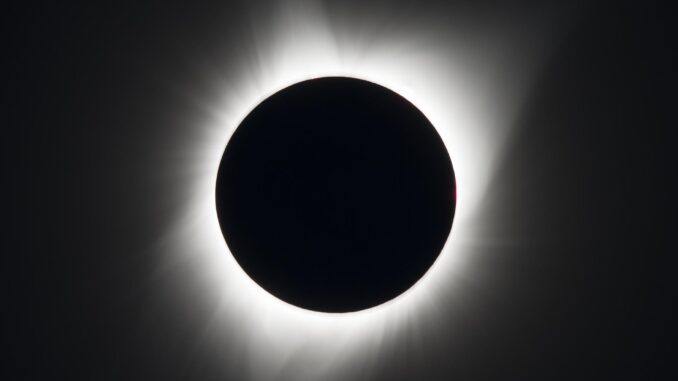
Lex Valluzzi, Staff Writer
Last Monday, April 8, a total solar eclipse passed through our country for the first time since 2017. A solar eclipse occurs when the moon travels in between the earth and the sun, blocking our earth’s view from the sun as it passes by. The path of the solar eclipse started in central Mexico and crossed into the United States in a diagonal path which left New York with an interesting view from all across the state.
At SUNY Oneonta, we were in 97% total. However other areas of New York State such as Buffalo, Plattsburg, Syracuse, Jamestown, Rochester, and Watertown were in 100% totality. Plenty of visitors flocked to Oneonta to view the eclipse from the President’s Garden outside of Milne Library. If you didn’t view the eclipse in full totality, you may have seen a partial solar eclipse on that day. For those in the country who were out of the eclipse’s path, it was viewed via livestream provided by NASA.
One of the most important things to remember about viewing a solar eclipse is eye protection. The sun is a lot brighter during the eclipse and can only be viewed safely wearing special glasses made specifically for solar viewing. Viewing glasses for the event were passed out on a first-come-first-serve basis at the A.J. Read Science Discovery Center located in the Physical Science building. Glasses could also be purchased in most stores, but it was revealed to the public that there are fake glasses going around not properly protecting your eyes. They advised citizens to ensure your glasses meet the safety guidelines before viewing an eclipse. To ensure the safety of your eclipse glasses, viewers checked for the ISO logo on the inner frame as well as the printed code IS 12312-2.
Around the time of the eclipse at SUNY Oneonta, it reached its peak at mid-noon and then the eclipse was completed before early evening. The total duration of the eclipse was two hours and twenty-six minutes. Oneonta students posted pictures and images they took to social media of their viewing of the eclipse. Some students stayed on campus to watch while others traveled to places with less light pollution for a better view.
It’s been reported that several more solar eclipses are coming in the near future. The first to be occurring in 2026 over Iceland, Portugal, and Northern Spain. The second eclipse is expected in 2027 when it passes over Northern Africa. And a third eclipse will occur over the Western and Southern parts of the United States in 2045. If you didn’t get to witness this rare celestial event, stick around because this will not be the last. It was a great experience for SNY Oneonta to witness the solar eclipse!
Leave a Reply